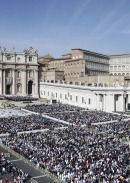Book Review: On pilgrimage with Newman
Article:
06.11.19
Book Review: On pilgrimage with Newman
Newman’s London – A Pilgrim Handbook, by Joanna Bogle, Gracewing, 84pp, £7.99
reviewed by Richard Whinder
The canonisation of John Henry Newman is undoubtedly a source of great joy for the whole Church – and especially for Catholics in England and Wales. His devotees longed for this day for many years, but for a long period his caused seemed to be faltering, largely for want of the required miracles. Now, however, we can see that God’s Providence has seen fit to raise Newman to the altar at the most appropriate time, for his gifts seem singularly fitting to our own moment in history. His utter devotion to the Truth, and fidelity to God’s call reproaches the relativism and secularism of our own times. His faithful adherence to the hierarchical Church – coupled with his rejection of a shallow and dangerous Ultramontanism - is a model for believers in every age. A man who truly lived the priestly ministry, his own personal holiness shines out all the brighter at a time when the priesthood – mired by scandal but so often, too, the object of unjust hostility – stands in need of renewal and reform. Last but by no means least, his wise and sensitive teaching on the development of doctrine can help us to interpret rightly the insights of the Second Vatican Council, always in fidelity to Tradition, and giving hope for the future.
Newman places
It is to be hoped that Newman’s canonisation will encourage a new wave of devotion to him, and in this, the small work under review has a valuable role to play. The author, Joanna Bogle, is herself a longtime admirer of the great Cardinal (indeed, your reviewer has fond memories of the talk on Newman she helped to organise at the time of his beatification – and of the Victorian marmalade cake she provided for the occasion!). Mrs Bogle always writes with enthusiasm, and this little book provides an erudite and enlightening introduction to Newman and to some of the places associated with him. The text is accompanied by some charming black and white illustrations by Malgorzata Brykczynska.
After a brief sketch outlining Newman’s life and work, we are taken first to Threadneedle Street, where the Cardinal was born; thence to Southampton Place, where his family moved when he was two years old; and on to Grey Court House at Ham, not far from Richmond. This was the family’s country residence (even today Ham retains a semi-rural air) and a place of happy memories for Newman. Here he recalled seeing candles being lighted in the windows to celebrate the victory at Trafalgar, and he swung on the trees and played among the gooseberry bushes. Later we move on to Ealing (where Newman was at school, when his father’s bank failed), to Norwood (where there was another house connected to the family), and to Grosvenor Place (where Newman’s Oxford friend and fellow Tractarian John Bowden lived, and Newman visited).
London, Birmingham and Oxford
The mention of Oxford, of course, reminds us that, although Newman was very much a Londoner by birth (indeed, arguably a Cockney, having been born within the sound of Bow Bells, as Mrs Bogle reminds us) he was to spend most of his life elsewhere, notably in Oxford and Birmingham. Sensibly, therefore, this book goes beyond the strict letter of its title, and includes excursions to these other cities. In Oxford one can see Newman’s colleges, Trinity and Oriel and visit his retreat at Littlemore, where Blessed Dominic Barberi received him into the Church. In Birmingham, there is St Mary’s College, Oscott, where he preached his famous ‘Second Spring’ sermon, and the Birmingham Oratory, where Newman devoted so much of his life to the priestly ministry, in imitation of his beloved St Philip Neri, the original Oratorian.
The book also introduces us to some of the churches and shrines honouring Newman, some of which he would have known personally (such as the Brompton Oratory, or Our Lady of the Assumption on Warwick Street) and some of which have a different connection (for example, the church of the Precious Blood, Borough, now cared for by the Ordinariate of Our Lady of Walsingham, to whom Newman has been such an inspiration – or St Aloysius’ church at Oxford, now home to that Oxford Oratory which Newman had so much wished to establish).
A call to holiness
The author concludes her work with Pope Benedict XVI’s homily, delivered on the occasion of Newman’s beatification in 2010 – and we cannot do better than to cite part of it here: ‘Cardinal Newman’s motto, “cor ad cor loquitur”, or “heart speaks unto heart”, gives us an insight into his understanding of the Christian life as a call to holiness, experienced as the profound desire of the human heart to enter into intimate communion with the Heart of God’.
Pilgrimage is one way in which that closer communion with God can be sought – and it is to be hoped that this ‘pilgrim guide’ will help many in their quest.
Notes:
Father Richard Whinder is a history graduateand Parish Priest of Holy Ghost Catholic Church, Balham, London.





